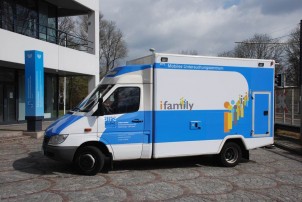I.Family Project Structure
The I.Family study is divided into 9 distinct work packages (WPs):
WP 1 Project management (Leader: UNIHB; Co-leader: BIPS)
WP1 – concerned with the overall management of the project and establishment of the necessary bodies and corresponding working structure to ensure a continuous and timely workflow between partners.
WP 2 Epidemiological platform (Leader: BIPS; Co-leader: UNIHB)
WP2 – to ensure the development of a common toolbox for follow-up of the study cohort to ensure the maximum degree of standardisation of data collection across the study centres.
WP 3 Assessment of dietary behaviours (Leader: INT; Co-leader: BIPS)
WP3 – further develop the dietary assessment tools already used in IDEFICS and the methodology of dietary assessment through an interactive web-based 24-hour dietary recall. One novel approach was the integration of a physical activity assessment tool.
WP 4 Biological and neurobehavioural susceptibility factors (Leader: ISA-CNR; Co-leader: UMC)
WP4 – develop the platform for the integration of different innovative approaches to develop a better understanding of the mechanisms underlying food selection. In this Work Package, strong links between basic research, genetics and genomics, neurobehavioural sciences and neuroimaging were established.
WP 5 Physical activity and the built environment (Leader: UBR; Co-leader ISA-CNR)
WP5 – drawing on the unique longitudinal strength of the diverse IDEFICS cohort two important objectives were assessed. Firstly, around behaviours and indices across the ‘physical activity spectrum’ and secondly on the built environment.
WP 6 The family and its environment (Leader: UGOT; Co-leader: UHEL)
WP6 – the family as the first step in a hierarchical approach to identify the factors driving food choice and eating habits.
WP 7 Consumer health behaviour and environmental factors (Leader: CBS; Co-leader UPE)
WP7 – identified the external factors of the nearer and wider environment of children and adolescents and their families. These external factors (i.e., the socio-economic, environmental, and cultural context) provide a “choice context” for nutrition behaviour. Recent experimental consumer research has shown that the “choice architecture”, i.e. the context and defaults of the setting, are crucial, and that they can ‘nudge’ consumers – in particular young consumers – to behave in specific ways.
WP 8 Consumer awareness, ethical acceptability and policy implications (Leader: ULANC; Co-leader: CBS )
WP8 – effective and pragmatic strategies on behavioural change, social marketing and health communication designed and tested, together with long-term policies to overcome ‘resistance to interventions’. Development of communication tools that are appropriate to families with different levels of awareness and health-related behaviours, linked to broader public policy strategies, particularly to the voluntary agreements and platforms that form an important plank of EU policy (e.g., the European Platform on Diet, Physical Activity and Health).
WP 9 Cascade platform (Leader: MIN; Co-leader: ULANC)
WP9 – cascade the knowledge created by the project, both amongst project members and externally, to build capacity, in particular by internal training and specific support for young researchers, to communicate with and to external stakeholders, and to ensure the exploitation and sustainability of the research base.







